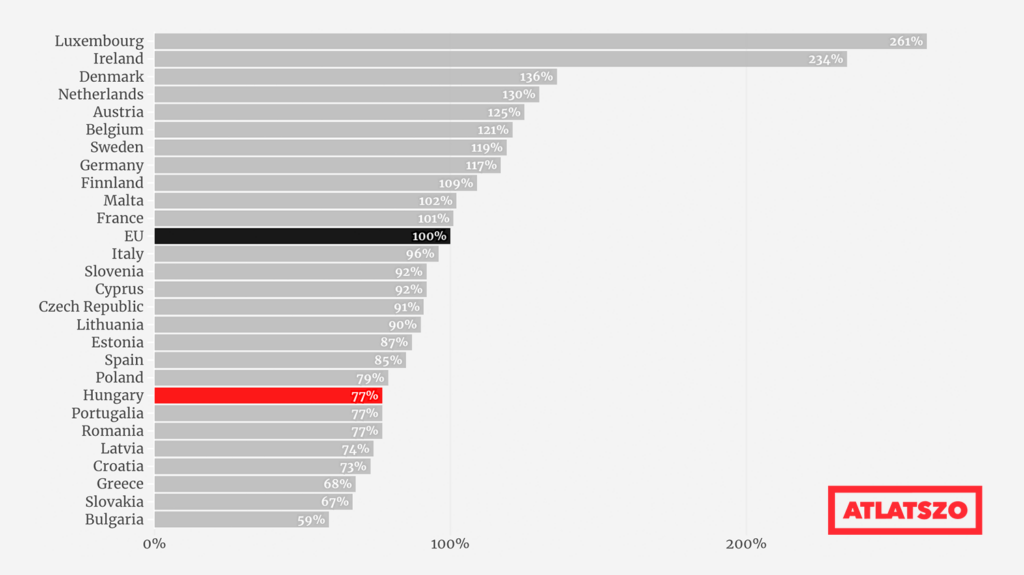The https://english.atlatszo.hu use cookies to track and profile customers such as action tags and pixel tracking on our website to assist our marketing. On our website we use technical, analytical, marketing and preference cookies. These are necessary for our site to work properly and to give us inforamation about how our site is used. See Cookies Policy
Romania has caught up with Hungary in terms of GDP per capita
In 2022, Hungary’s GDP per capita was 23% below the EU average, ranking eighth from the bottom in Eurostat’s comparison. According to preliminary data, we have caught up with Portugal, while Romania has caught up with us for the first time in a decade. Luxembourg had the highest GDP per capita, well above the EU average. Bulgaria was at the bottom of the list.
Hungary’s GDP per capita has improved, bringing it in line with Portugal but losing the advantage over Romania, according to preliminary data from Eurostat. The international comparison, which covers the 27 EU countries, is based on purchasing power parity.

Purchasing Power Parity is a measure of Eurostat, an artificial exchange rate: it puts different currencies into a common one, and corrects the price level between countries, making their GDP comparable.
GDP in most EU countries has grown by an average of 2.7% over the past year. The most significant change in the region’s ranking was seen in Romania. For the first time in 11 years, as recorded by Eurostat, Romania’s GDP per capita overtook that of Hungary. Moreover, the difference was not a small one in 2011: our eastern neighbour has since made up a 12 percent gap.
Hungary was close to the EU average in 2022, with GDP per capita increasing from the 2021 level of 75 percent. In 2022, preliminary data show that our GDP was 77 percent, which means Hungary was 23 percent below the EU average.
This puts us eighth from the bottom of the EU. Our GDP per capita grew by 2 percent, catching up with Portugal by 2022 – meaning that Hungarian, Portuguese and Romanian GDPs are currently the same.
Out of the 27 EU countries, Luxembourg has by far the highest GDP per capita, 161% above the EU average. The report explains this partly by the large number of foreign residents working in the country and thus contributing to GDP, while not being part of Luxembourg’s permanent population.
Ireland ranks second among Member States, 134% above the EU average. It is followed by Denmark, the Netherlands, Austria and Belgium, where GDP per capita is more than 20% above the average. Eurostat attributes Ireland’s high level of GDP per capita partly to the presence of large multinationals investing in intellectual capital. The associated contract manufacturing with these assets contribute to GDP, while a large part of the income earned from this production is returned to the companies’ ultimate owners abroad.
GDP per capita is above the EU average in Sweden, Germany, Finland, Malta and France. Italy, Slovenia, Cyprus and the Czech Republic are less than 10 percent behind, followed by Lithuania, Estonia and Spain at minus 10-20 percent.
GDP per capita in Poland, Hungary, Portugal, Romania, Latvia and Croatia is less than 30% below the EU average, while Greece and Slovakia are less than 40% below. At the bottom of the list is Bulgaria, where GDP per capita is 41% below the EU level.
Written and translated by Luca Pete. The original Hungarian version of this story can be found here.

